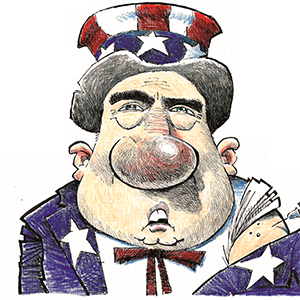Dieter Kurtenbach: Even after 4 years and 45 starts, the NFL doesn't understand Brock Purdy
Published in Football
There is a stubborn narrative in football that insists on placing the most important and dynamic players on the field — quarterbacks — into neatly defined boxes.
There’s the devil-may-care “Gun Slinger,” the veteran (it’s always someone over 30) “Field General,” and, most damningly, the robotic, unremarkable but reliable “Game Manager.”
For the better part of his young, meteoric career, Brock Purdy has been shackled to that last, reductive label. He was unheralded coming into the league as the last pick of the 2022 draft, and he went into an offensive system in San Francisco that turned mediocre, underpowered quarterbacks into stat-stacking, game-winning quarterbacks.
Of course, he was just another Kyle Shanahan creation —an ’80s point guard: a thoughtless, egoless triggerman.
There are still folks who believe this about Purdy.
Even with all his success, and even with his new, quarter-of-a-billion-dollar contract, he will always be that to a far-too-large portion of the public — a group of people who refuse to take in new evidence that could contradict their initial beliefs.
They should watch a game sometime.
The 49ers put 41 points on the board on Sunday, and while seven of them were gift-wrapped by a 98-yard kick return, it was a hell of a day at the office for Purdy’s offense.
And the success is not a byproduct of Shanahan scheming up some after-the-catch yardage — the kind of dink-and-dunk-and-let-him-run offense that we saw under Nick Mullens, Jimmy Garoppolo, and even Purdy’s backup, Mac Jones. No, it’s because Purdy, the “manager,” pushed the ball down the field with an aggression and efficiency that fundamentally changes this team’s offensive calculus.
If only it could change his public perception, too.
The Niners need their offense to be at the vanguard of a late-season playoff push. But that seems entirely possible with No. 13 back at the helm, challenging defenses and keeping them honest not only with his feet, but by pushing the ball downfield at an elite level.
And if the eye test hasn’t already told you that, perhaps the numbers will.
Compared to his backup, Jones, Purdy completes 37%t more passes on 20-plus-yard passes than expected, per NFL data. (Jones is at minus-11%, Purdy plus-27.)
Quarterback ratings on passes over 20 yards in the air?
— Purdy 106.3
— Jones 32.8
Purdy has completed 7 of 10 such deep passes in his 99 total pass attempts this season. He’s pushed it 10% of the time.
Jones, on the other hand, had four completions in 16 deep attempts. He pushed the ball on five%of his throws.
You could feel that difference on Sunday.
Yes, there’s a reason why batting average doesn’t matter in baseball anymore, folks — it’s all about the long ball. The same is true in football.
There are other circumstances behind this quarterback discrepancy, to be sure — Jones was playing with third-string receivers for a good deal of his time under center. But Purdy’s deep-ball prowess is not a new development: Last year he had a passer rating of 87 on deep attempts, despite having the third smallest average separation from his wide receivers in the league (minimum 40 deep passes.)
Jones’ receivers put up the same average separation in 2025. He was the worst-rated deep-ball thrower in the NFL this season.
And when Purdy did have massive separation from his receivers — 3 yards on average in 2023, second-best in the NFL that season — Purdy put up huge numbers on deep throws. On them, he led the league in quarterback rating, 143.3, completions over expectation, plus-16%, and led the league in expected points added per dropback (1.44).
Those are MVP-caliber numbers, and Purdy finished fourth in the balloting.
Yes, Purdy is a deep-ball thrower — one of the best in the NFL, in fact.
So why did I receive multiple messages after Sunday’s game from fans bemoaning his lack of arm strength compared to Jones, the NFL’s second-worst deep-ball thrower (per EPA) in 2023 and worst in 2024?
Is it as simple as Jones is 6-foot-3, carries a bit of weight, stands strong in the pocket, and looks like he should have a cannon for an arm?
Is it as straightforward as the fact that Purdy can’t see over his linemen (that’s not a shot, he admitted it), is maybe 220 pounds, and plays like a squirrel at the dog park, ducking, spinning, and escaping on seemingly every play?
At what point does the actual on-field product overcome biases?
That’s a legitimate question, because I don’t understand how this is still a thing.
The good news is that the 49ers players, coaches, and decision makers are under no such disillusions — they see Purdy for what he is: More Dan Marino (the reason Purdy wears No. 13) than Mark Rypien; more Brett Favre than Brad Johnson.
“Having explosive big plays is huge,” Kittle said Sunday. “What, five plays into the game, he hits me 30 yards down the field on a perfect pass? He’s got his swagger.”
And that swagger is the antidote to the packed boxes and lurking safeties that have become the blueprint for slowing the 49ers in recent weeks. The deep ball is the ultimate deterrent, forcing a defense to defend every blade of grass, stretching it thin until the inevitable breaking point — a point that, for San Francisco, will likely arrive well past the 30-point threshold.
If we need to put quarterbacks in a box, let’s at least put Purdy in the right one.
He’s a gunslinger, a 25-year-old field general.
To call him a stay-out-of-the-way game manager is simply embarrassing.
We’re four years and 45 starts into his career. It’s time to drop the priors and see Purdy for what he is.
____
©2025 MediaNews Group, Inc. Visit at mercurynews.com. Distributed by Tribune Content Agency, LLC.







Comments